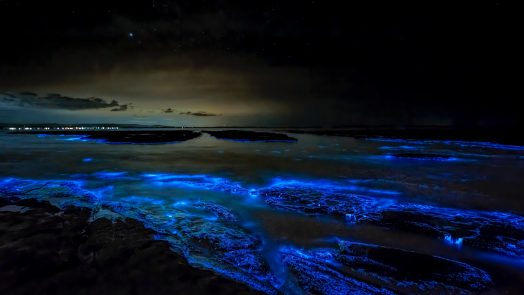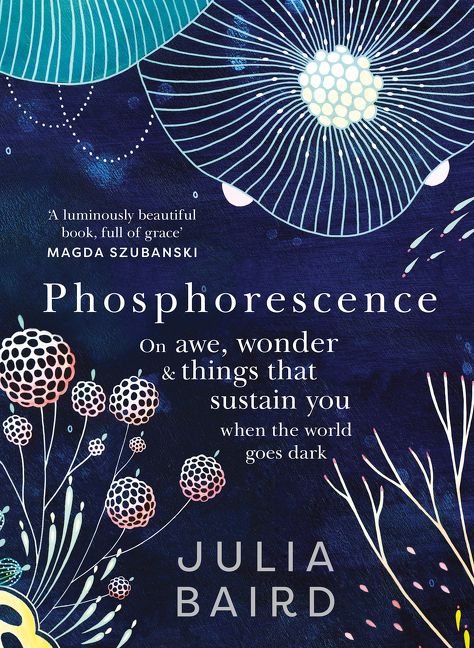Contemplating Phosphorescence

Can we see the beauty, the desirability, of atypical, even disabled bodies?…To recognise and accept our own beauty requires us to break away from the shackles of our social conditioning.

It was at lunch with Julia Baird in the canteen of the ABC offices in Sydney that I learned she was writing a book on awe and wonder as the means of navigating dark times. It was her first day back in the office after a lengthy period of recovery from stomach cancer, and we were interrupted by a series of famous faces welcoming her back and wishing her well. It is pathetic, I know, but I confess to a moment of jealousy, not about her fame, but that she was finishing the book that I had planned on writing (but of course, had not yet started), about the pursuit of beauty as the way to a truer and deeper life, and the only meaningful response to personal crisis and tragedy. When I later read the text, I knew I would have to find a different topic.
Baird’s passion for beauty was sparked in her 20s, when she ventured with friends at night “into the black sea, diving and swirling under the moon, watching a silvery, sparkling ribbon of phosphorescence trail behind our limbs … we were streaming sequins, or galaxies, in our wake.” Baird uses these living lights as a metaphor for “flashes of life in the middle of the dark, or joy in difficult times.” As these sentences show, Phosphorescence is a beautifully written work (the medium is the message). Drawing on an eclectic mix of her own experiences, stories, history, theology, philosophy and science, Baird shows how the pursuit of nature’s beauty — too often out of reach of people living in noisy modern cities — has the capacity to soothe and heal. She connects the natural world to silence, by which she means not the absence of noise, but the absence of noise made by humans. If we paused more often to hear it, she suggests, silence has the power to connect us to the sublime. More broadly, the awe and wonder we feel when we bathe in the natural world encourages imagination and creativity, and takes us beyond ourselves, toward the spiritual (a word she rightly leaves undefined).
Ocean bathing is central to Baird’s insight into beauty. She is a devoted ocean swimmer, starting each day (no rest for the wicked in winter) with a 1.5 km swim from Manly Beach out to the headland and back. As an ex-surfer, I understand her passion for the sea. The last time I surfed was a decade ago. Waking at dawn and dragging my oldest son out of bed and down to the beach, we paddled out in offshore winds to clean waves and the rising sun. I like to remember it with dolphins catching waves beside us (which happened sometimes, whether on this morning I am unsure). We watched the sunrise, enjoyed the adrenaline thrill of steep waves, and experienced nature at its most beautiful. Later that day I broke my neck.
For many years after, I hated the beach. It was a vivid reminder of what spinal cord injury had stolen from me. On the few occasions I ventured to the coast, I would pretend to enjoy myself so as not to get my friends and family down. But behind the fake smile was the ache of loss. Many years later, rolling my wheelchair along a path on the beach at Austinmer in the Illawarra, I realised with some surprise that I was enjoying the beauty that surrounded me; escarpment in the background, tall pine trees providing shade overhead, the speckled mess of sand, green and blue light shining through the waves, filled with the babble of families playing and young people surfing. It was not Baird’s absence of noise made by humans, but even so, I was immersed in the joy that comes from our connection to nature. And what I experienced when I looked at the waves, even at the surfers enjoying them, was not loss or jealousy, but the delight of beauty.
I was discovering that spinal cord injury forced upon me certain advantages, especially in slowing me down. I had spent much of my life beforehand rushing through the never-ending activities of family, work, and sport, taking little time to stop and smell the roses. Now I had no choice, and discovered that the smell and the site of flowers was delightful, something to savour.
Baird talks about savouring as an art, which involves paying attention to pleasure; looking forward to a pleasure to come, taking time to enjoy it, and reminiscing about it afterwards. The words “awe” and “wonder” in the title of her book may mislead us into thinking that we need to look for the spectacular, but savouring is more about noticing the delight we can have in everyday experiences. Savouring is an art that does not come naturally to many of us, but it can be cultivated by taking time each day to notice something beautiful. I learned to savour by drinking expensive whiskey, paying attention to the complexities of its nose, its taste, and its afterglow. You cannot have this experience if you down the drink in a single shot, which gives you nothing more than a burnt gullet and a light head. Instead, you must pause before drinking to notice the aroma, take a small sip and rest it on your tongue, use your imagination to discern its delights (is it vanilla, maple syrup, or smoky peat), before swallowing and enjoying the warmth that passes down the throat.
The pursuit of beauty is not ‘the key’ to happiness, or the panacea for life’s ills. Baird does not want to make the shallow suggestion that we should or can always look for the glad, bright, and shiny bits of life. Loss, pain, ugliness, injustice, fear, anger, and impotence go together with the vulnerabilities of creaturely life. But she does want to suggest that beauty can find us in surprising times and places, and stimulate the resilience and hope that enables us to hold on for better days.
Talking about the pursuit of beauty raises the issue of self-acceptance in a society whose economic system is grounded in creating ideals (body image, fashion, housing, travel) that impel us to spend money on ever shifting goals that can never be reached. The absurdity of this system is highlighted in the context of disability. In the 1980s, women with disability in Australia protested the Miss Australia Beauty Quest, which was used by the Spastic Centre to raise tens of millions of dollars over its fifty-year history. The contest continued for twenty years after these protests, because the charity could not do without the funds. In so doing, it entrenched the alienation (the declared ugliness) of the very people it purported to help. Every beauty product on the market place exactly the same game.
Can we see the beauty, the desirability, of atypical, even disabled bodies? Various disability Instagram accounts are making the case (@disabled_fashion, @disabledbeauties), and nondisabled people are also highlighting the absurdity of our society’s image of the body beautiful (@celestebarber). To recognise and accept our own beauty requires us to break away from the shackles of our social conditioning. It is no easy task, and I confess to having largely failed. I hate my crippled body, its hunched neck and shoulders, crab-like curled fingers, stomach distended by unused muscles. It is torture to look in the mirror naked, colostomy on my belly, and catheter coming from my navel. Baird, who struggles with the length of her nose, suggests that ugliness can be freeing, that it enables us to focus on other types of beauty. Perhaps learning to see our beauty and embrace our ugliness can enable self-acceptance and empower us to protest against ableist stereotypes (where ableism labels prevailing beliefs about the normal body and self that is promoted as fully human, against which disability is judged as less than human, a tragedy to be fixed or hidden away).
Christian messianic traditions connect the paradox of ugliness and beauty to Christ. In Isaiah 53 the Messiah is identified as disfigured, with nothing in his appearance that we should desire him, despised, rejected, stricken, smitten, afflicted, one from whom people hide their face (i.e. ugly). But if we resist our inclination to turn away from disfigurement and observe his life all the way to the cross, even the ugliness of crucifixion becomes beautiful. The cross stands as a reminder that disfigurement can be magnificent and ugly events can unearth rich meaning.
I have been surprised to discover that spinal cord injury is not an interminable tragic horror. While its hardships are always present, they fade into the background next to the generosity of family and friends, the vibrancy and strength of people with diverse disabilities, and the discovery that, if I take the time to look, I am surrounded by beauty.
Written by Shane Clifton. Shane is Professor of theology and ethics, honorary associate at the Centre For Disability Research And Policy at the University of Sydney, and Assistant Director, Research, at the Royal Commission into Violence, Abuse, Neglect and Exploitation against People with Disability.
Images used are sourced from Upsplash.com
